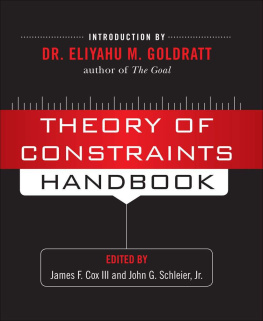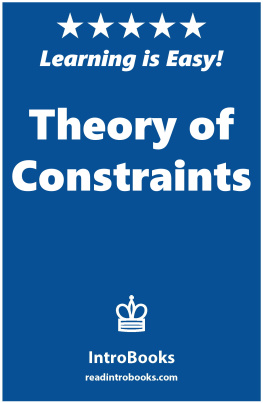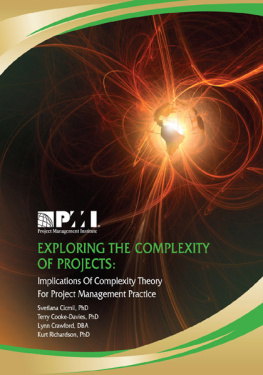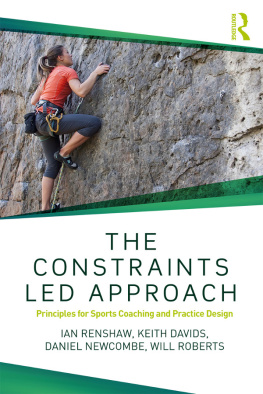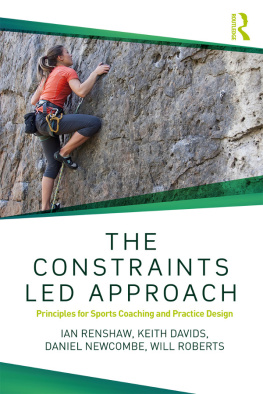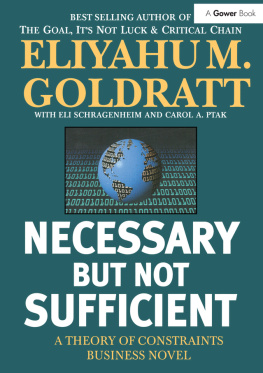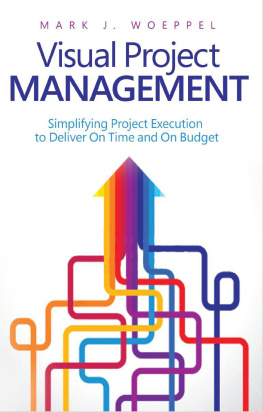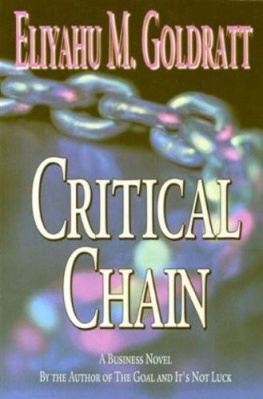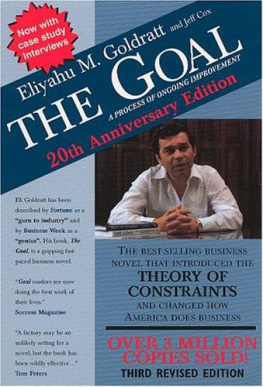Theory of Constraints Handbook
About the Editors
JAMES F. COX III, PhD, CFPIM, CIRM, holds TOCICO certifications in Production and Supply Chain, Performance Measurement, Critical Chain, Strategy and Tactics, and Thinking Processes. He is a JONAHs JONAH, Professor Emeritus, and was the Robert O. Arnold Professor of Business in the Terry College of Business at the University of Georgia. He has conducted numerous academic and practitioner Theory of Constraints workshops and programs on performance measurement, production, supply chains, management skills, project management, and the thinking processes.
Dr. Coxs research has centered on the Theory of Constraints for over 25 years. He has authored or co-authored three books on TOC and almost 100 peer reviewed articles. He was the co-editor of the APICS Dictionary, 7th, 8th, 9th, 10th, and 11th editions, and an invited contributor on the topic of Constraints Management to the Production and Inventory Management Handbook.
Dr. Cox has been a member of APICS for over 30 years, holding chapter, regional, and national offices. He served on the APICS Board of Directors for four years with two years as VP of EducationResearch and served on the APICS Educational and Research Foundation Board of Directors for nine years with four years as President. He was a founding member and elected to the founding Board of Directors of the Theory of Constraints International Certification Organization (TOCICO), a certification organization founded by Dr. Eli Goldratt. He later served as Director of Certification responsible for implementing TOCICOs certification program.
Now retired, JOHN G. SCHLEIER, Jr. was President and Chief Operating Officer of the Mortgage Services Division of Alltel, Inc., Executive Vice President of Computer Power, Inc., and Director of Office Systems and Data Delivery for IBM. In these positions, he directed major software development projects, sales administration, and financial functions. He was also Director of Information Systems for IBMs General Systems Division, where he provided oversight for Development Engineering, Manufacturing, and Headquarters systems. He developed information systems for manufacturing, sales, and IBM strategic planning functions and was winner of an IBM Outstanding Contribution Award. He was a regular lecturer on Strategic Planning at IBM Executive Briefing Centers over a period of 15 years, speaking to CEOs and top executives of major corporations. He frequently took consulting assignments dealing with complex project management issues around the world.
He served on the faculty of The University of Georgia College of Business Administration as IBM Executive in Residence and later as Executive Professor of Management, serving on both the Management Information Systems and Production Operations Management faculties. Mr. Schleier holds TOCICO certification in all disciplines. He co-authored Managing Operations: A Focus on Excellence, a college text emphasizing TOC concepts (North River Press, 2003). He also published Turkey Tales, a childrens book (Tate Publishing, 2010).
Theory of Constraints Handbook
Edited by
James F. Cox III
John G. Schleier, Jr.


Copyright 2010 by James F. Cox, III and John G. Schleier, Jr. All rights reserved. Except as permitted under the United States Copyright Act of 1976, no part of this publication may be reproduced or distributed in any form or by any means, or stored in a database or retrieval system, without the prior written permission of the publisher.
ISBN: 978-0-07-166555-1
MHID: 0-07-166555-2
The material in this eBook also appears in the print version of this title: ISBN: 978-0-07-166554-4, MHID: 0-07-166554-4
All trademarks are trademarks of their respective owners. Rather than put a trademark symbol after every occurrence of a trademarked name, we use names in an editorial fashion only, and to the benefit of the trademark owner, with no intention of infringement of the trademark. Where such designations appear in this book, they have been printed with initial caps.
McGraw-Hill eBooks are available at special quantity discounts to use as premiums and sales promotions, or for use in corporate training programs. To contact a representative please e-mail us at bulksales@mcgraw-hill.com.
Information contained in this work has been obtained by The McGraw-Hill Companies, Inc. (McGraw-Hill) from sources believed to be reliable. However, neither McGraw-Hill nor its authors guarantee the accuracy or completeness of any information published herein, and neither McGraw-Hill nor its authors shall be responsible for any errors, omissions, or damages arising out of use of this information. This work is published with the understanding that McGraw-Hill and its authors are supplying information but are not attempting to render engineering or other professional services. If such services are required, the assistance of an appropriate professional should be sought.
TERMS OF USE
This is a copyrighted work and The McGraw-Hill Companies, Inc. (McGraw-Hill) and its licensors reserve all rights in and to the work. Use of this work is subject to these terms. Except as permitted under the Copyright Act of 1976 and the right to store and retrieve one copy of the work, you may not decompile, disassemble, reverse engineer, reproduce, modify, create derivative works based upon, transmit, distribute, disseminate, sell, publish or sublicense the work or any part of it without McGraw-Hills prior consent. You may use the work for your own noncommercial and personal use; any other use of the work is strictly prohibited. Your right to use the work may be terminated if you fail to comply with these terms.
THE WORK IS PROVIDED AS IS. McGRAW-HILL AND ITS LICENSORS MAKE NO GUARANTEES OR WARRANTIES AS TO THE ACCURACY, ADEQUACY OR COMPLETENESS OF OR RESULTS TO BE OBTAINED FROM USING THE WORK, INCLUDING ANY INFORMATION THAT CAN BE ACCESSED THROUGH THE WORK VIA HYPERLINK OR OTHERWISE, AND EXPRESSLY DISCLAIM ANY WARRANTY, EXPRESS OR IMPLIED, INCLUDING BUT NOT LIMITED TO IMPLIED WARRANTIES OF MERCHANTABILITY OR FITNESS FOR A PARTICULAR PURPOSE. McGraw-Hill and its licensors do not warrant or guarantee that the functions contained in the work will meet your requirements or that its operation will be uninterrupted or error free. Neither McGraw-Hill nor its licensors shall be liable to you or anyone else for any inaccuracy, error or omission, regardless of cause, in the work or for any damages resulting therefrom. McGraw-Hill has no responsibility for the content of any information accessed through the work. Under no circumstances shall McGraw-Hill and/or its licensors be liable for any indirect, incidental, special, punitive, consequential or similar damages that result from the use of or inability to use the work, even if any of them has been advised of the possibility of such damages. This limitation of liability shall apply to any claim or cause whatsoever whether such claim or cause arises in contract, tort or otherwise.
Contents
Aggregate Stock at the Highest Level in the Supply Chain:
The Plant/Central Warehouse (PWH/CWH)
1 For Appendices A and C to G see http://www.mhprofessional.com/TOCHandbook.
Preface
Beginning in the early 1980s with the OPT software, a software package for scheduling manufacturing operations, Dr. Eliyahu M. Goldratt started applying the concepts of the hard sciences to problems in organizations. Later, with the publication of
Next page
